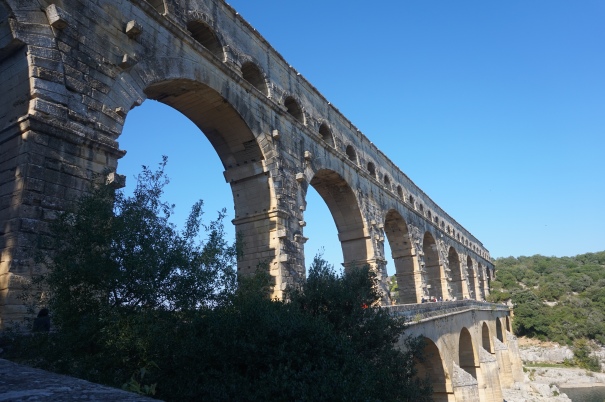Pont de Gard
Not all Roman ruins are in Italy. The Empire was vast. We’ve climbed Roman walls in England, found a statue of Trajan in a far-flung field in Romania. When we visited Cahors, France, we couldn’t use the municipal parking lot because, when expanding it, workers discovered Roman ruins. All work stopped and the archaeologists were called in. These ruins are a patrimony to be conserved and appreciated.
France, when it was Gaul, was a part of the Roman Empire. One of the most impressive relics of that time exists almost intact: The Pont de Gard in Provence.

The Pont de Gard is an aqueduct built in the first century AD to direct water from a mountain spring to the Roman colony at Nimes. Of course, it fell into disuse when the Western Empire collapsed. Fortunately during the Middle Ages it was used as a toll bridge, so remains more or less intact.


Jim, being an engineer, has a lot of knowledge and something to say about aqueducts.
Aqueducts by Jim Mauro
Roman aqueduct technology gave the Roman population an advantage of better health over competing civilizations and better food supply as they also supplied water for their extensive crops. The technology included: gravity feed at a minimum slope of 1 to 4000, periodic maintenance required a conduit large enough for a person to enter through the regular openings; also at regular intervals, pools dug down, would collect sediment; if the topography was too steep steps in the conduit or large receiving pool to catch the falling water and release it into a lower conduit would be used. They also developed a form of concrete called putoleum that would cure under water and was water proof. Rome in the year zero received from its aqueducts as much water as New York City in the year 2000. When a large festival with many animals was staged in the Coliseum, after it was over the whole bottom area was flushed out to the river.
The aqueduct scene that most people think of is of arches supporting the water conduit, but in reality most of the aqueduct is below grade and through mountains/hills, only 20% is above grade. Some of the techniques used by the aqueduct engineers for siphoning water over depressions are still used by today’s hydraulic engineers.


In the Naples area the “Augustus” aqueduct was built to supply the Southern Fleet stationed in Mycenium northwest of Naples. It terminated in the “Piscina Mirabalis” which is a One Million gallon holding facility built exclusively for the fleet.


In Naples itself at Virgil’s tomb you can walk through a section of the aqueduct. It is about 5 feet high & 2 feet wide. The bottom & sides up to 4 feet are covered with putoleum cement as the rock in Naples is largely tuffa that is porous.
